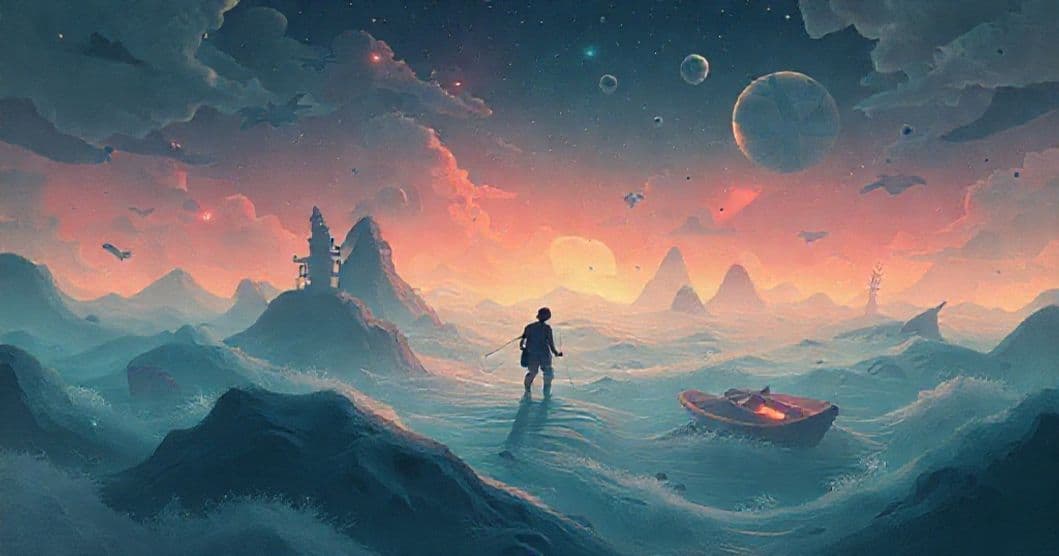Part 1: Dream Presentation
Dreams often serve as interactive narratives where the unconscious mind tests our responses to familiar and unfamiliar scenarios. This particular dream, structured like a video game experience, offers a compelling exploration of how we navigate uncertainty, seek control, and process emotional challenges in our waking lives. The dream begins in a three-dimensional, game-like environment—an artificial world where movement feels both constrained by rules and liberating in its virtuality. This setting immediately suggests a space where the dreamer’s identity and agency are fluid, a metaphor for how we sometimes feel adrift in roles or expectations.
The dreamer encounters a horse, a powerful symbol of freedom and connection to primal instincts. Riding the horse represents moments of empowerment, where the dreamer feels in control of their direction and pace. The horse’s sudden disappearance after the dreamer dismounts hints at a temporary loss of agency, as if the dreamer must transition from relying on external support (the horse) to independent action. Collecting blue stars introduces a sense of purpose and achievement—the stars as tangible rewards for exploration. Their cool, electric blue color suggests clarity, spiritual aspiration, or the pursuit of something intangible yet meaningful.
The shift to red 3D diamonds marks a critical turning point. These angular, predatory shapes represent obstacles or threats that transform from abstract to immediate. The dreamer’s instinct to attack triggers a swarm of pursuit, symbolizing how perceived threats escalate when we react defensively. The voices that emerge as the dream intensifies—muffled, judgmental, and seemingly external—reflect internalized criticism or the pressure to perform in waking life. Finally, the post-waking vision of swirling blue and red patterns acts as a lingering residue, a visual echo of the emotional intensity experienced during the dream.
Want a More Personalized Interpretation?
Get your own AI-powered dream analysis tailored specifically to your dream
🔮Try Dream Analysis FreePart 2: Clinical Analysis
Symbolic Landscape: Video Game Elements and Archetypal Imagery
The dream’s video game structure itself is a powerful symbol of how we process daily life as a series of challenges and objectives. In Jungian terms, the game world represents the persona’s interaction with the collective unconscious—rules, rewards, and threats that mirror our waking priorities. The 3D environment embodies the dreamer’s need for structure and direction, yet the fluidity of movement suggests a desire for spontaneity within that structure.
The horse is a classic Jungian archetype—the animus/animus figure, representing the dreamer’s connection to primal, instinctual energy. Riding the horse reflects moments of confidence and alignment with one’s true nature, while its disappearance signals a transition to self-reliance. The blue stars, collected with purpose, symbolize the dreamer’s capacity for achievement and spiritual growth. Their electric blue hue connects to the third eye chakra in Eastern traditions, suggesting insight or intuitive understanding.
The red diamonds introduce the shadow archetype—repressed fears or challenges that demand attention. Their faceted, predatory nature reflects how we often misperceive threats as immediate and overwhelming, even when they’re abstract. The swarm response mirrors how anxiety amplifies small problems into crises, a common pattern in high-stress periods. The voices, though indistinct, represent the dreamer’s internal critic or external expectations—someone (or something) watching and judging performance.
Psychological Currents: From Freud to Jung
Freudian analysis would likely interpret the dream as wish fulfillment, where the video game represents a desire for escape from real-world responsibilities. The horse ride embodies the dreamer’s need for freedom, while the stars symbolize achievements deferred in waking life. The chase by red diamonds could reflect repressed anger or fear of failure, with the dreamer’s initial attack representing an attempt to regain control.
Jungian psychology offers a complementary perspective, viewing the dream as a dialogue with the unconscious. The horse as a guide archetype suggests the dreamer’s need for self-discovery through intuition. The blue stars as spiritual symbols connect to the collective unconscious, representing the dreamer’s search for meaning beyond mundane concerns. The red diamonds, as shadow elements, signal unresolved conflicts or suppressed emotions that demand integration.
Neuroscientifically, this dream aligns with the default mode network’s activity during sleep—our mind’s natural tendency to process emotions, memories, and future scenarios. The game-like structure reflects how our brain organizes information into coherent narratives, using familiar patterns (like video games) to make sense of complex feelings.
Emotional & Life Context: Unpacking the Narrative
This dream likely emerges from a period of transition or uncertainty in the dreamer’s life. The horse ride, with its sense of freedom, suggests a longing for autonomy or a desire to reconnect with passions that feel neglected. Collecting blue stars could reflect a current focus on small, meaningful goals or spiritual practices.
The shift to red diamonds and pursuit suggests mounting pressure—perhaps from work, relationships, or self-imposed expectations. The dreamer may feel caught between needing to control outcomes and being overwhelmed by external demands. The voices watching could represent social anxiety or fear of judgment, especially in performance-oriented contexts.
The post-waking vision of blue and red patterns hints at residual emotional intensity, suggesting the dream is processing unresolved feelings. The dream’s resolution—waking up with these visual echoes—reflects how deeply the unconscious work is impacting the conscious mind, even after the dream ends.
Therapeutic Insights: Interpreting the Game Dream
For the dreamer, this experience invites reflection on their relationship with control and freedom. The horse symbolizes moments of ease and alignment; perhaps the dreamer should identify more opportunities to reconnect with this sense of flow in waking life.
The red diamonds suggest that perceived threats are often more manageable than they appear. Journaling about specific stressors and whether they’re as overwhelming as the dream’s chase could help demystify them. The voices, as internal critics, might benefit from mindfulness practices to separate self-judgment from self-compassion.
Actionable steps include: 1) Creating a
